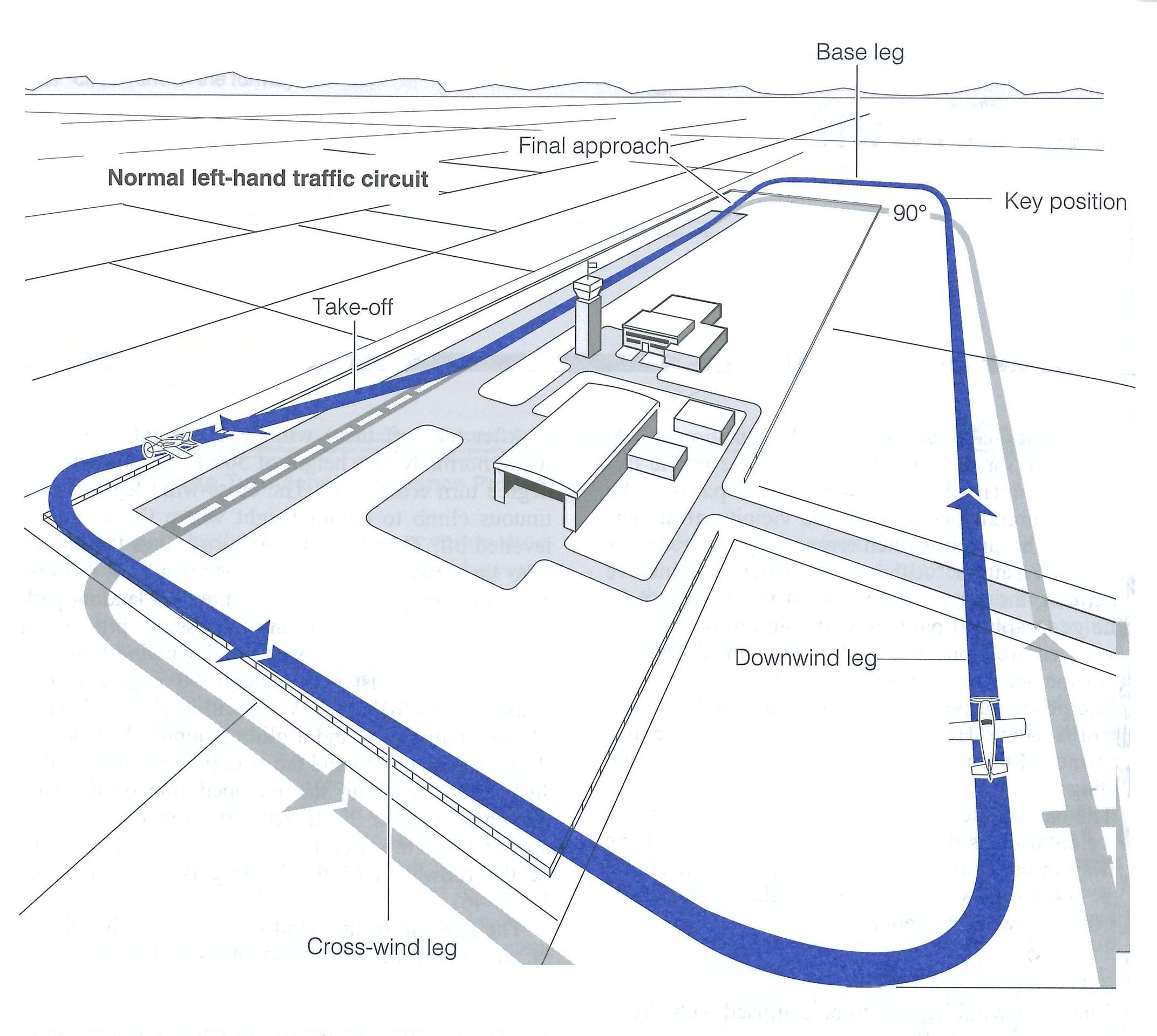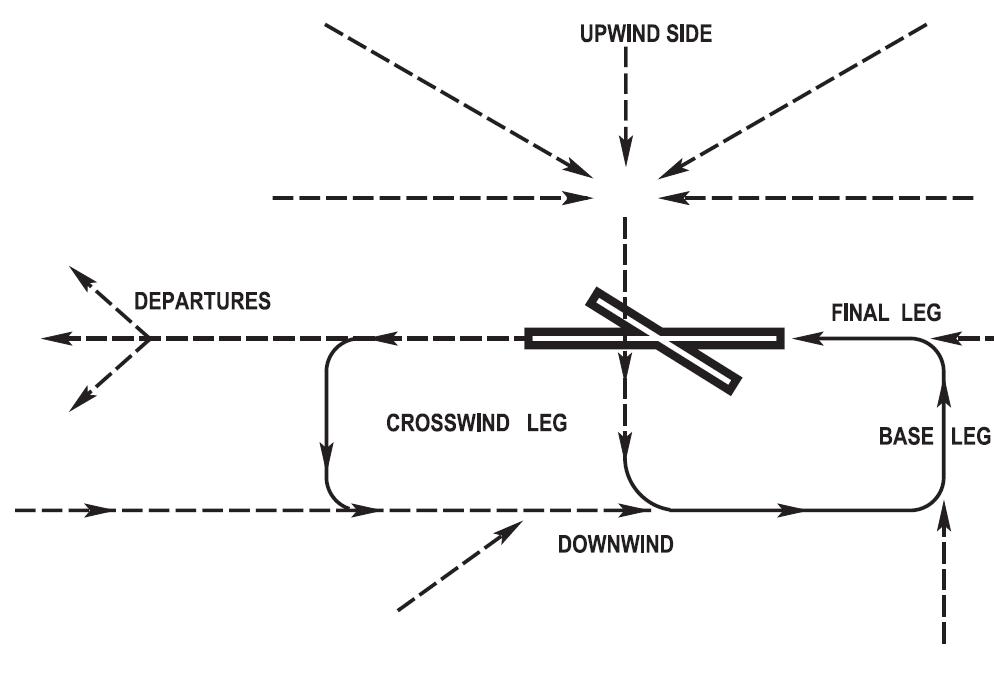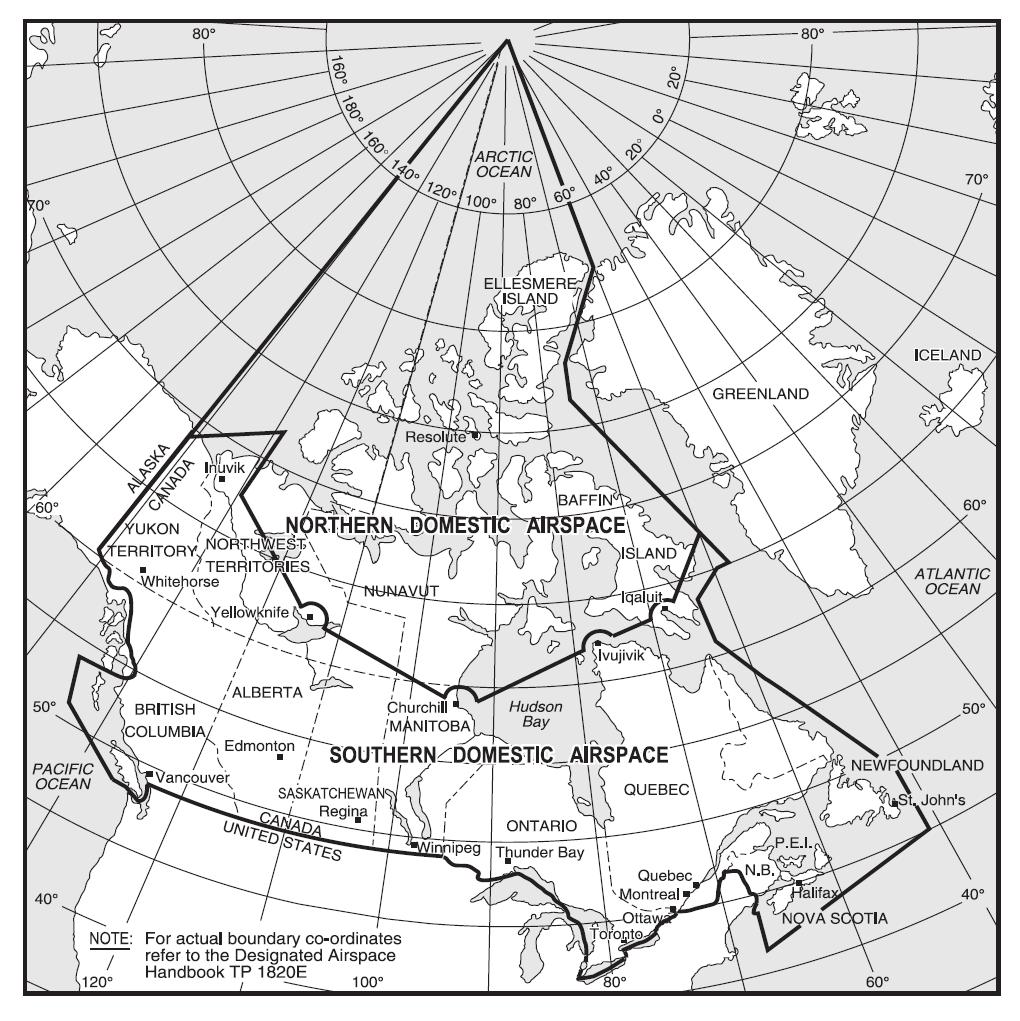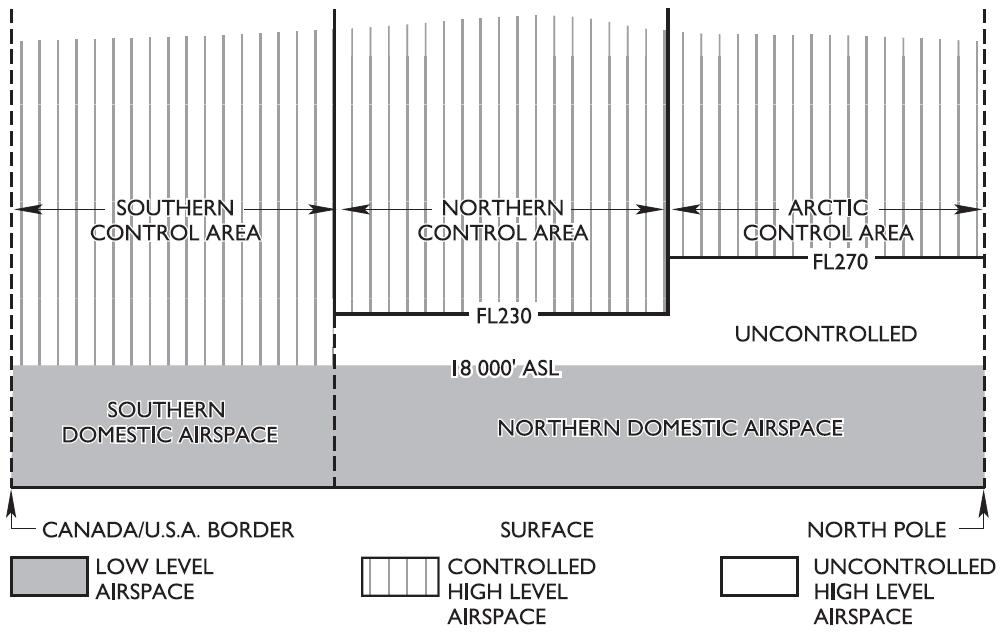CANADIAN AVIATION REGULATIONS PART I
- CANADIAN AVIATION REGULATIONS PART I
- Organization
- Airports
- The Circuit
- Mandatory Frequency Airports
- Control Zone Airports
- ATC Clearances and Instructions
- Airspace Classification
- VHF and LF Airways
- Airport Airspace
- VFR Weather Minimum
- Special VFR
- VFR Over-the-Top
- Cruising Altitudes
- Altimeter Setting Rules
- National Security
- Emergency Location Transmitters (ELT)
- Transponder Requirements
- Fuel requirements
- Alcohol
- Seat Requirements
- Use of Oxygen
- Oxygen Equipment and Supply
- Documents on Board Aircraft
- Aircraft Equipment Requirements
- Flight over Water
- Aircraft Icing
- Minimum Altitude
- Speed Limits
- Rules of the Air
Organization
The CARs, as they are referred appear quite complicated at first, but are in fact quite logical in design. First, the CARs are generally divided into two parts, the first is referred to as “the Regulations,” and the second is known as “the Standards.” In short, the Regulations prescribe the rules, while the Standards provide guidance on how to operationalize or practise the rules. The Standards are effectively guidelines.1
The CARs are in turn divided into eight “Parts,” or “subject areas” as follows:2
- Part 1 General Provisions
- Part 2 Aircraft Identification and Registration
- Part 3 Aerodromes and Airports
- Part 4 Personnel Licensing and Training
- Part 5 Airworthiness
- Part 6 General Operating and Flight Rules
- Part 7 Commercial Air Services
- Part 8 Air Navigation Services
The format of regulation/standard identification is based on three-digit numbers. All “regulations” applicable to Part 7, Commercial Air Services, for example, are in the 700-number series. The “seven” and the first “zero” will not change for all the regulations in that Part, but the third digit does change. For example, within Part 7, the following “subparts” exist:
- Subpart 0 700-series General
- Subpart 1 701-series Foreign Air Operations
- Subpart 2 701-series Aerial Work
- Subpart 3 703-series Air Taxi Operations
- Subpart 4 704-series Commuter Operations
- Subpart 5 705-series Airline Operations
- Subpart 6 706-series Aircraft Maintenance for Air Operations
So when we discuss Air Taxi operations below, reference will be repeatedly made to 703-series (Subpart 3) regulations—those three numbers will not change, but the numbers behind the decimal point will.
How do the “standards” relate to the Subparts? Quite simple, actually. All standards that apply to the 703-series will have a “2” as the second digit—723-series—with the numbers behind the decimal point (which identify specific subjects within the “subpart”) remaining the same. Thus, if you want to find out the specifics (standards) on the requirements for an Operational Flight Plans in Air Taxi operations (CAR 703.18), you simply have to look in the equivalent “standard” —identified as CAR 723.18 (some use CAS 723.18) and entitled the same.
The “down-side” of the CARs is that they have not yet published a comprehensive “subject index” where you can find where stuff is buried among the subparts—until then, you will have to “dig.” The CARs are easily accessed on the Web—there is a link on LangleyFlyingSchool’s Website (www.langleyflyingschool.com).
References
1 The word “guidelines” is potentially misleading here, as the Standards can be enforced as statute law just as the Regulations can—the only difference is that they provide greater “statutory” detail.
2 There is another Subpart, but it is not relevant to the discussions.
Airports
Two types: an aerodrome: which is “any area of land or water designed for arrival, departure, and movement of aircraft,” and an airport, which is an aerodrome that is certified by Transport Canada for either public or private use.
The pilot of an aircraft must report his landing to the operator of the airport (or his representative) listed in the Canada Flight Supplement. Incidentally, the Canada Flight Supplement is essentially a directory of all published airports in Canada and describes the physically layout of runways and taxiways, radio frequencies, etc.—information that is crucial for the pilot to refer to when flying to an airport or aerodrome. (Unless otherwise indicated, reference in this manual to “airports” will generically imply both certified airports and non-certified aerodromes.)
Runways and Taxiways
Runways are numbered in accordance with magnetic track in Southern Domestic Airspace (as opposed to true track in the Northern Domestic Airspace), the number is rounded to the nearest 10° increment, and the third digit is dropped (340° equals 34).
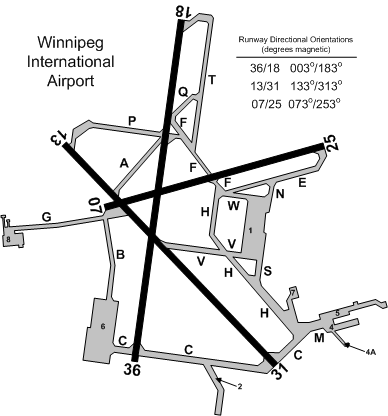
Taxiways are lettered (Alpha for A, Bravo for B, etc.). Aprons (aircraft loading and servicing areas) are numbered. Yellow lines track the centre of taxiways, and broad crossing yellow lines indicate the “hold-short” positions.
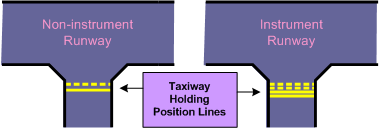
A closed runway or taxiway is indicated by a white or yellow “X” that is 20 ft. in length. Where a runway at an airport does not have a prepared landing surface, the takeoff and landing area will be delineated by international orange and white markers; at an aerodrome, the same area will be shown by international orange markers (no white).
The minimum runway lighting required for night operations at an airport is two parallel lines of fixed white lights visible for two miles and which marks the landing and takeoff areas. Some registered aerodromes are approved to use retro-reflective markers instead of runway lights.

Mandatory Instruction Signs are signs located where a taxiway leads onto a runway and instructs the pilot to hold short and clear the runway; these signs are indicated by white letters, numbers, or symbols against a red background.
Where aircraft movements are supervised by a Control Tower, Mandatory Instruction Signs require that a clearance be received by the pilot before proceeding further; where aircraft movements on a runaway are not controlled by a control tower, the pilot can only proceed beyond a Mandatory Instruction Sign if he or she has determined it safe to do so.
The manoeuvring area of an airport or aerodrome refers to the areas used for the taking off and landing, as well as taxiing of aircraft, but excludes the aprons. Aprons denote areas were passengers and cargo are loaded and unloaded, and where aircraft are serviced or parked.
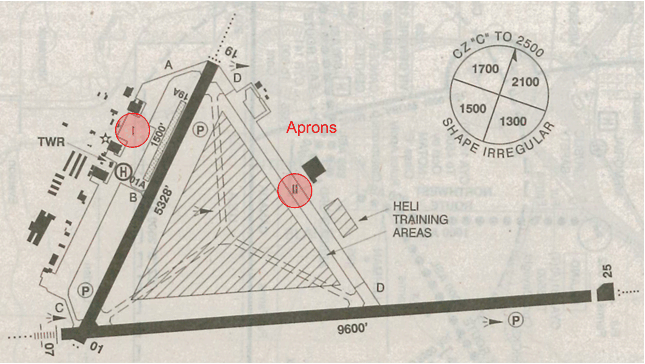
It is prohibited for persons to walk, stand, drive or park any vehicle, or cause any obstruction of aircraft movement at an airport without permission from a control tower or from the operator of the airport where a control tower does not exist. Additionally, no person may allow any animal in their care to run at large within the boundaries of an airport.
Windsocks indicate wind direction and speeds. The windsock is horizontal for winds greater than 15 KT, 5° below horizontal for 10 KT, and 30° below for 6 KT.
The Circuit
Traffic circuits (referred to as “traffic patterns” in the U.S.) are standard patterns located 1000’ AGL (above ground level) flown by aircraft for the purposes of landing and taking off. They are composed of two sides: downwind and upwind. In a standard circuit, the downwind side is the active side, while the upwind side is the “dead” side. The active side is comprised of four “legs”: crosswind leg, downwind leg, base leg, and final.
Uncontrolled airports lack Air Traffic Control (ATC); instead, pilots broadcast their positions on a UNICOM VHF frequency (listed in the Canada Flight Supplement). We refer to such airports as “ATF” airports—Aerodrome Traffic Frequency.(AIM-RAC 4.5.5)
When departing from an uncontrolled airport, pilots broadcast prior to moving onto a runway, when commencing takeoff roll, and when clear of the circuit.
When arriving, they report their position (including altitude), intention and ETA when 5 minutes from the airport area; they report when joining the circuit, when established on final approach, and when clear of the runway after landing.
Pilots flying continuous circuits report midway point on the downwind leg, when on final, and when clear of the runway after landing.
NORDO (no radio) aircraft operate freely at uncontrolled airports.
To reduce the risk of traffic conflict, the rules for joining the circuit are restrictive. At ATF airports pilots must position themselves on the upwind side of the active runway (runway in-use) and cross over to the downwind side at circuit altitude. Crossing over the runway in this manner, the track of the aircraft is essentially perpendicular to the downwind leg. When the pilot has sufficient distance from the runway to provide room to manoeuvre the aircraft, a left turn or right turn (depending on the direction of the published circuit) is made to enter the downwind leg abeam the mid-point of the runway. A pilot may also join straight in on the downwind leg (at circuit altitude), but only if this does not create a hazard to other aircraft. Whenever joining the circuit, the pilot should report over the radio if able when turning on to the downwind leg.
Mandatory Frequency Airports
Busy uncontrolled airports have mandatory frequencies (MF) (AIM-RAC 4.5.4), as published or indicated in the Canada Flight Supplement.
Typically MF airports are those which are busier than ATF airports, but not busy enough to warrant a control tower. They are also typically found at airports with frequently used instrument approaches, where pilots use navigation equipment to make an approach for landing while still in the clouds (without visual reference to the ground).
At a MF airport, position reporting by pilots over a prescribed VHF frequency is mandatory, and all pilots must maintain a listening watch.1 A pilot’s intentions must be broadcast prior to entering the manoeuvring area at a MF.2
There are two types of MF airports, the first is referred to as simply a MF airport, and the second is referred to as a MF Area airport (MFA). MFA airports are MF-rule airports that lack a ground station—e.g., FSS. They are essentially ATF airports where position reporting and radio monitoring is required; the rules for joining the circuit are identical to those for an ATF airport. At an MF airport (not an MFA airport), the rules for joining the circuit are more flexible to facilitate aircraft manoeuvring for landing after performing an instrument approach—pilots may join the circuit straight-in on the final or base legs.
During a departure from an MF airport, the pilot must report the departure intentions prior to moving onto the take-off surface. Before taking off, the pilot must ascertain by radio and visual means that there is no risk of collision, and after takeoff, the pilot must report departing from the circuit.3
When arriving at an MF airport, the pilot must broadcast the aircraft’s position, altitude, estimated time of landing, and arrival intentions prior to entering the MF area; where circumstances permit, this broadcast shall be made at least five minutes prior to entering the MF area.4
When flying continuous circuits at an MF airport, pilots must report when joining the downwind leg, when on final approach, including intentions, and when clear of the landing surface.5
When flying through an MF area, the pilot must report before entering the MF area and, when circumstances permit, at least five minutes before entering the area. The pilot must also report clearing the MF area.6
Control Zone Airports
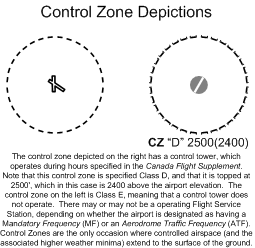
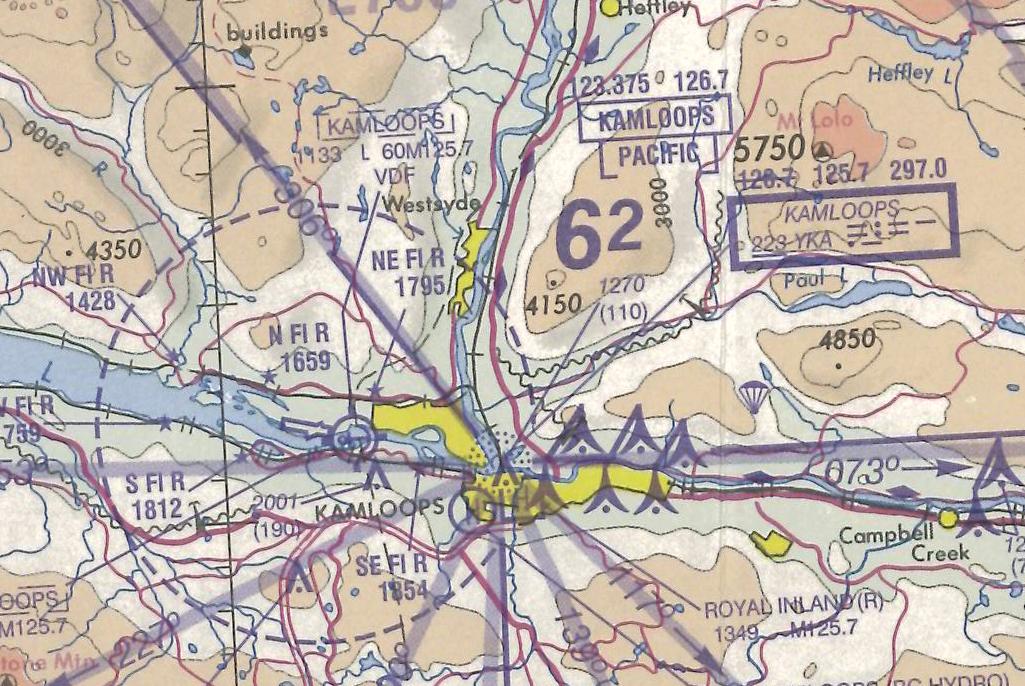
Controlled airports are surrounded by control zones (AIM-RAC 2.7.3), which are controlled by an Air Traffic Control Unit (ATCU), usually a control tower (control zones are discussed later in this chapter). However, some control zones, such as those that surround Nanaimo and Kamloops Airports, are administered by FSS where MF rules are in effect. As a rule, control zones with control towers are considered to be Class C or D Control Zones, while control zones with FSS using MF rules are considered Class E Control Zones (classifications and Control Zones are further discussed later in this chapter).
Prior to entering the control zone a pilot must contact the ATCU—control tower or FSS—and report his position and intentions. Where a control tower is operating, a clearance will be provided. In all control zones, pilots must maintain a listening watch.
The tower controller may provide specific clearances, or he may say “cleared to the circuit”(AIM-RAC 4.4.2) whereby the pilot is expected to join the downwind leg at circuit height.
Controlled airports have ATIS broadcasting frequencies (Automatic Terminal Information Service) that are monitored by pilots prior to entry (published in the Canada Flight Supplement).
NORDO traffic is restricted from entering control zones unless they receive special permission.
When NORDO flights are permitted, or in case of communication failures, tower controllers use a light gun to communicate clearances:
|
SIGNAL |
GROUND AIRCRAFT |
AIR AIRCRAFT |
|---|---|---|
|
Flashing Green |
Cleared to taxi |
Return to land |
|
Steady Green |
Cleared to takeoff |
Cleared to land |
|
Flashing Red |
Taxi clear of runway |
Airport unsafe |
|
Steady Red |
Stop |
Do not land; continue circling. |
|
Flashing White |
Return to starting point |
— |
|
Blinking Runway Lights |
Vacate runway immediately |
— |
|
Red Pyrotechnical |
— |
Do not land for the time being |
Light communications are acknowledged by the pilot by rocking the wings (day) or by a single flash of the landing light (night).
ATC Clearances and Instructions
Controllers issue two types of directives to aircraft in controlled airspace: a clearance, and an instruction. When a pilot has received and accepts a clearance, the clearance must be complied with, unless the pilot feels it unacceptable. If the pilot feels it is unacceptable, he or she must immediately inform ATC of this fact.
Acknowledgement of a clearance by a pilot is viewed by ATC as the pilot’s acceptance.
In contrast, an ATC instruction requires that a pilot comply unless aircraft safety is jeopardized.
An ATC clearance will be identified by the word “clear” somewhere in its contents. An ATC instruction will be readily identified, but need not include the word “instruct.”
IMPORTANT: Complying with a clearance or instruction does not relieve the pilot from any responsibilities for maximum flight safety and good Airpersonship (including obstruction clearance and distance from cloud or other aircraft).
References
1 CAR 602.97(2).
Airspace Classification
The geographic classification of Canadian Airspace is specified in the Designated Airspace Handbook.
Northern and Southern Domestic Airspace
Canadian Airspace is divided into two fundamental areas: Northern Domestic Airspace (NDA) (AIM-RAC 2.2.1) and Southern Domestic Airspace (SDA). The division has a few important rules: While the proper cruising altitude in the SDA is based on magnetic track, cruising altitude in the NDA is based on true track (discussed below). Additionally, runway headings are also based on magnetic track in the SDA, while true track is used in the NDA. Finally, rules for altimeter settings are also based on the SDA/NDA division. Generally, NDA consists of airspace located north of Inuvik, Yellowknife, Churchill, Ivujvik and Iqaluit.
Canadian airspace is further divided into seven classes, each providing individual rules of access, flight regulations, and Air Traffic Control (ATC) responsibility.
IMPORTANT: Do not confuse the seven classes with rules of weather minimum, which are quite different. Weather minima are established based on the fundamental difference between controlled and uncontrolled; for practical purposes, of the seven classes, only Class G is uncontrolled airspace.
The characteristic of the seven classes may be summarized as follows: (AIM-RAC 2.8)
Class A
- All high-level controlled airspace (AIM-RAC 2.3)—in SDA, all airspace from 18000’ to Flight Level (FL) 600 (60000’), and in the NDA, the ceiling of Class A rises to 23000’ (FL230) and 27000’ (FL270), in the Northern Control Area, and Arctic Control Area, respectively.
- All aircraft must have a clearance.
- Only IFR flight is permitted.
- Altimeters are set to standard pressure—29.92” Hg.
Class B
- All low-level controlled airspace from above 12500’ up to, but not including, 18000’.
- All aircraft must have a clearance.
- Only IFR and Controlled VFR flight is permitted.
- Altimeters are set to local pressure settings.
- Transponders are required with Mode C (altitude encoding) capability.
- Altimeter must have been tested within last 24 months.
- Adequate navigation equipment required for flight planned route.
Class C
- Specifically defined airspace around designated airports described as terminal control areas and associated control zones.
- Controlled airspace whereby both IFR and VFR are permitted but where VFR flights cannot enter until they receive a clearance from ATC.
- ATC provides traffic separation to IFR flights, while VFR receives traffic information (and conflict resolution upon request).
- The Pilot-in-command has the responsibility to avoid other aircraft, maintain terrain and obstruction clearance, and remain in VFR weather.
- While operating in Class C, aircraft must be equipped for two-way radio communication, and must maintain a continuous listening watch.
- Transponders are required with Mode C (altitude encoding) capability.
- Class C airspace reverts to Class-E status when ATC services are not operating.
Class D
- Specifically defined airspace around designated airports described as terminal control areas and associated control zones.
- Controlled airspace whereby both IFR and VFR are permitted, but where VFR flight must establish two-way communication with an appropriate ATC authority prior to entry.
- IFR flights are provided with separation, while traffic information is provided to VFR flights.
- While operating in Class D, aircraft must be equipped for two-way radio communication, and must maintain a continuous listening watch.
Class E
- Specifically defined airspace normally associated with airways, control area extensions, and transition areas, including designated airports without an operating control tower.
- Controlled airspace where both IFR and VFR flight may operate; separation is provided to IFR flights, but there are no special requirements for VFR flights.
- A Transition Area (AIM-RAC 2.7.5) is an area of defined dimension, based at 700’ AGL, and extends upward to the overlying controlled airspace—it is found at airports where frequent IFR operations occur and are designed to increase separation between IFR and VFR aircraft in poor weather conditions.
- A Control Area Extension (AIM-RAC 2.7.2) serves the same purpose as a Transition Area, except it is always based at 2,200’ AGL’ and extends up to but not including 18000’ ASL (unless otherwise indicated).
Class F
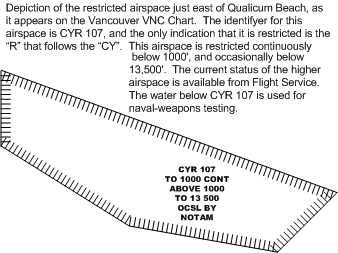
- Airspace in which special activities take place, which may or may not restrict air traffic.
- Class F airspace is specifically described in VFR Navigation Charts (VNCs), as well as in the Designated Airspace Handbook.
- The type of Class F airspace is indicated in the identifier published in charts, of which the following is a typical example: CYA123(T). “CY” indicates that the airspace is in Canada. The third letter, in this case “A,” indicates the type of airspace; there are three types—“R” meaning restricted and “D” meaning danger, both of which cannot be entered as specified on the chart (“D” only appears in relation to restricted airspace in international waters), and “A” meaning advisory, which can be entered. Class F areas designated CYA are associated with special flight activity and caution should be used. The type of activity is indicated by the letter in parentheses “(T)” where “T” indicates flight training. Others are acrobatics (A), test flight areas (F), military training (M), hang gliding (H), parachuting (P), and soaring by gliders (S).
- Unless otherwise specified, the radio frequency 126.7 MHz should be monitored in Class F areas.
- Class F restricted areas (CYR) may be created by NOTAM and may therefore not appear on charts.
Class G
- Airspace not designated A, B, C, D or F, within which ATC has no authority or responsibility.
- Uncontrolled airspace for both IFR and VFR traffic.
- Unless controlled airspace is specified on a chart, Class G uncontrolled airspace extends up to, but not including, 18000’ in the SDA. The ceiling of uncontrolled airspace varies in northern Canada.
The schematic below provides a summary of the airspace classification in Canada.
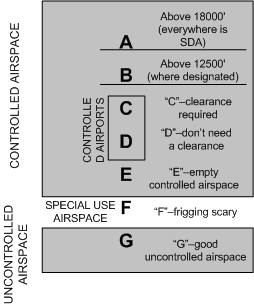
VHF and LF Airways
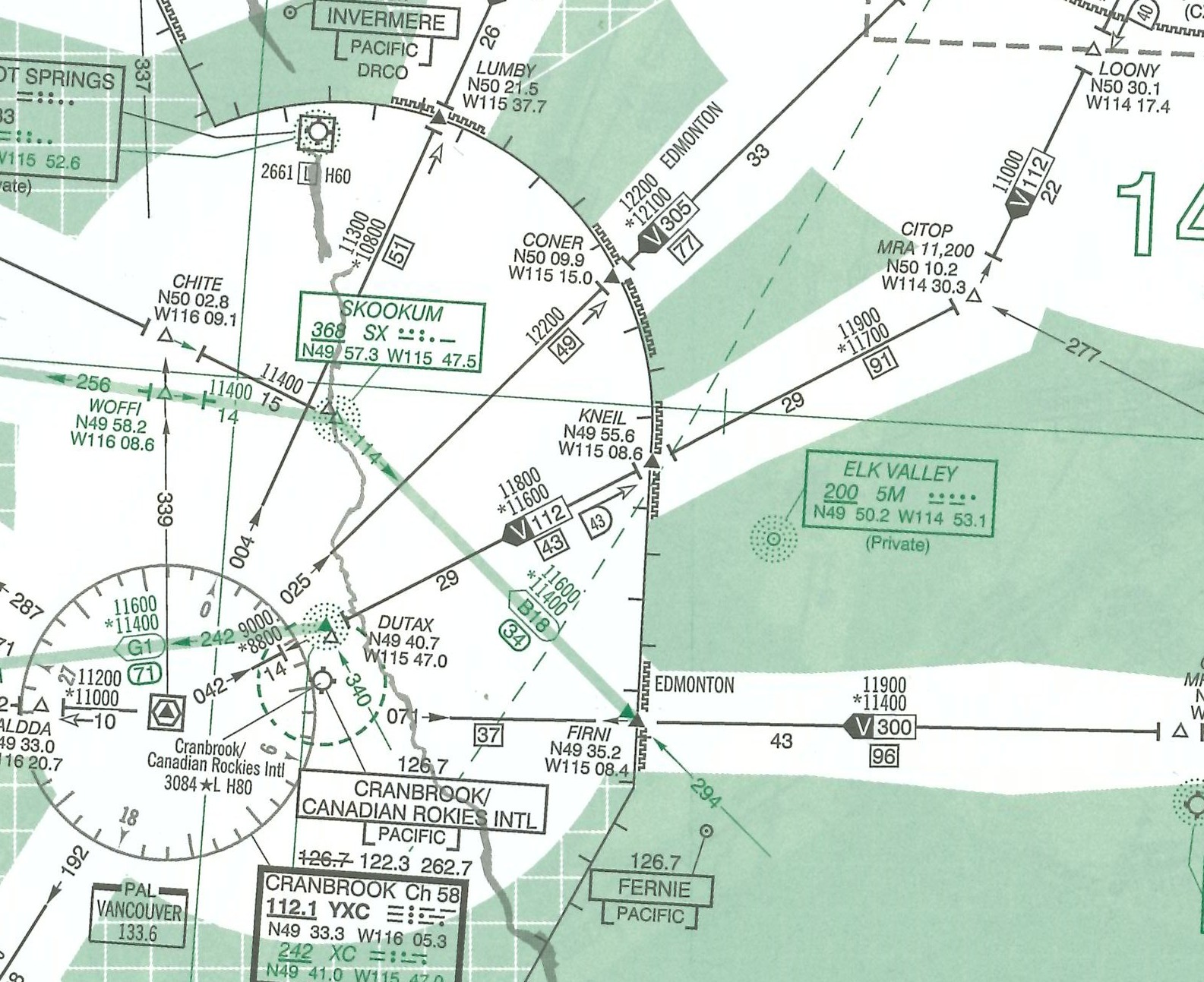
Class E airspace between VHF Omni Range (VOR) transmitters and LF/MF (Non-Directional Beacon or NDB) transmitters form airways.(AIM-RAC 2.7.1)
Airways have specified dimensions indicated on charts; they are always controlled airspace and therefore specified weather minima apply to VFR flight.
At or above 12500’ (i.e., up to 18000’) airways are automatically defined as Class B airspace, and therefore the requirements of Class B apply.
Where airways penetrate designated airports surrounded by Class C or D airspace, as indicated on charts, the respective rules of Class C or D airspace also apply.
Unless otherwise indicated on charts, airways are automatically based at 2200’ AGL.
Airways between VORs are referred to as Victor Airways(V21 for example). They have a minimum width of 4 NM on either side of the VOR, which expand, or are splayed by 4.5° from the centre line. After a distance of 50.8 NM from a VOR, the splay begins to increase the width of the airway.
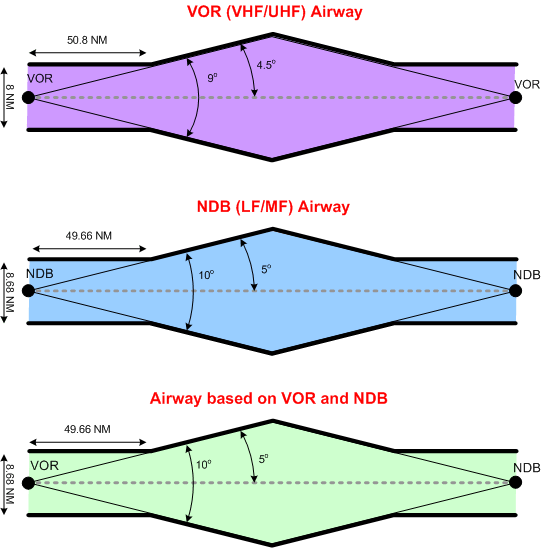
Airways between NDBs have the same base and ceiling, but their minimum width is 4.34 either side of the beacon, and splay by 5° from the centre line. After a distance of 49.66 NM from a NDB, the splay begins to increase the width of the airway. Note that airways which combine NDBs with VORs utilize the NDB dimensions.
Airport Airspace
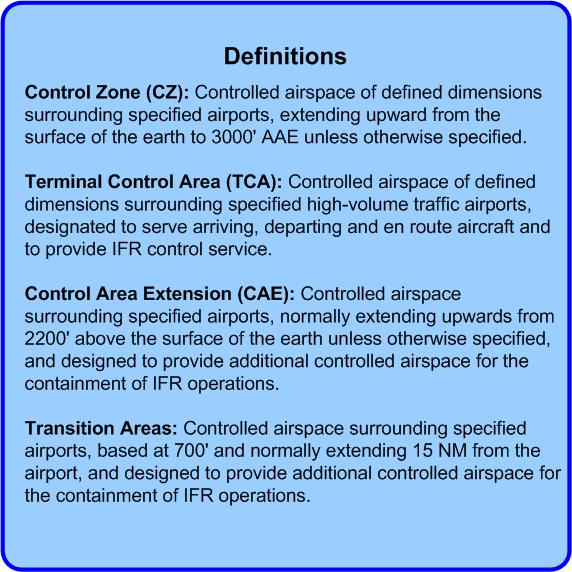
Control Zones surround specified airports; they usually have a 7 NM (nautical mile) radius and extend from the surface to 3000’ AAE (above aerodrome elevation). They may be designated Class B, C, D or E airspace. VFR flight in non-VFR meteorological conditions is governed by special weather minima described below.

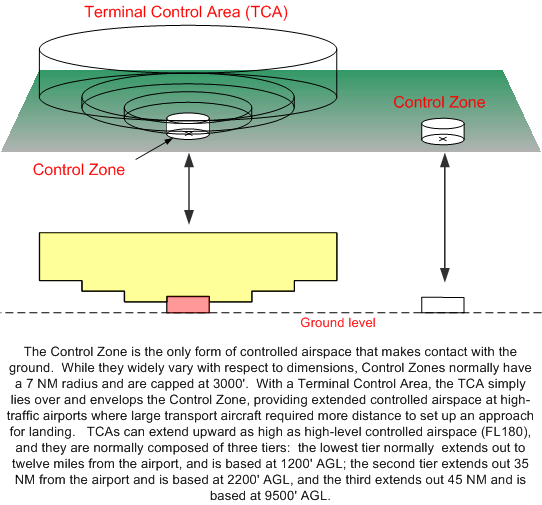
Control Zones associated with larger airports are, as mentioned earlier, commonly surrounded by Terminal Control Areas, Transition Areas, or Control Area Extensions, as shown on charts. This expanded controlled airspace is designed to provide separation between aircraft in high-density traffic areas. Large transport aircraft, for example, will require more than 7 NM to descend for landing. At Vancouver International Airport there is a 7NM Control Zone; but surrounding the Control Zone is 45 NM radius Terminal Control Area (TCA) which has the dimensions of an inverted “wedding cake;” as you get closer to the Control Zone, the floor of the TCA gets closer to the ground in accordance with numerous “step down” sectors. The rules of the Vancouver Control Zone (Class C Airspace) are the same as the Vancouver TCA—a clearance from ATC is required prior to entry, Mode C Transponder, etc.
VFR Weather Minimum
VFR flight in all airspace can only occur when conditions are above established VFR weather minima that specify distance from existing clouds, flight visibility, and, in the case of Control Zones, height above ground.
As discussed above, there are two rules—weather minima for controlled airspace, and minima for uncontrolled airspace. A further distinction is made for flight inside and outside Control Zones, and flight at or above 1000’ AGL and flight below 1000’ AGL.
Accordingly, VFR weather minimum varies with the airspace categories, described below:
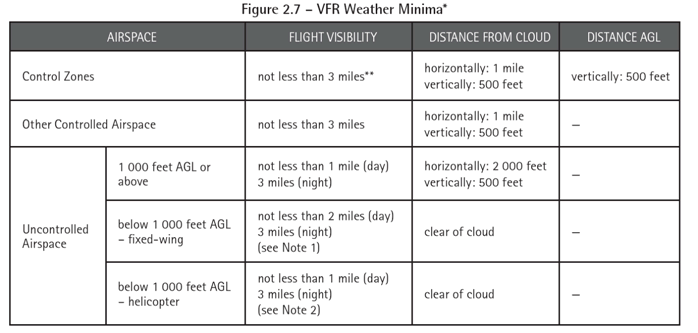
Special VFR
In Control Zones (described above), VFR pilots can enter when the weather is below the above described if they receive special permission—referred to as Special VFR.
Special VFR is never offered; it must be requested by the pilot. The minimum for Special VFR is 1-mile flight and ground visibility (when reported). At night, Special VFR will only be authorized for the purpose of landing at a destination airport.
VFR Over-the-Top
This requires the pilot to be VFR-OTT qualified, and it requires specified weather minima during the cruise portion of flight and at the destination airport.
VFR-OTT is only permitted during the day.
At all times the aircraft must be operated at least 1000’ vertical distance from cloud, and the flight visibility must be at least five miles.
When operating between two layers, those layers must be at least 5000’ apart.
On the basis of a Terminal Aerodrome Forecast (TAF) or a Graphic Area Forecast (GFA), the weather at the destination airport must be scattered or clear, with no forecast of precipitation, fog, thunderstorms, or blowing snow; where a TAF is used, these conditions must be forecast for a period no less than 1 hour before and 2 hours after the ETA; where a GFA is used, these conditions must be forecast no less than 1 hour before and 3 hours after the ETA
Cruising Altitudes
When flying the SDA above 3000’ AGL, VFR flights flying west-bound (magnetic track of 180° to 359°) must fly at even 1000’ altitudes plus 500’; when flying east-bound (magnetic track of 360° to 179°) VFR flights must fly at odd 1000’ altitudes plus 500’. Remember that true tracks are used in the NDA.
Altimeter Setting Rules
For altimeter use, the SDA is referred to as the Altimeter Setting Region (AIM-RAC 2.10) ( where the altimeter must be continually set to the nearest reported altimeter setting.
Here are the rules that apply to the Altimeter Setting Region:
- Before takeoff, the altimeter must be set to the reported setting for the departure airport, or, if not available, the airport elevation.
- During flight, it must be set to the setting of the nearest reporting station.
- Prior to landing, it must be set to the destination airport if available.
NDA is referred to as the Standard Pressure Region,(AIM-RAC 2.11) where it is required that the Altimeter be set to 29.92”Hg—known as standard pressure. The exception to this is prior to descent for landing and before taking off, when the airport setting, if available, or elevation is required. When standard pressure is used by the pilot, he must refer to his altitude as flight level where, for example, 5500’ is Flight Level 55.
More specifically, here are the rules (CAR 602.36) that apply to altimeter practices in the Standard Pressure Region:
- Prior to conducting a departure in the Standard Pressure Region, the pilot shall set the altimeter to the current altimeter setting of the airport.
- Immediately prior to reaching the cruising flight level, the pilot shall set the altimeter to standard pressure; if the cruising flight level is above FL180, the altimeter shall be set to standard pressure immediately after passing through FL180.
- Prior to beginning a descent with the intention to land, the pilot shall set the altimeter to the current altimeter setting of the intended airport.
- When transitioning between the Altimeter Setting Region and the Standard Pressure Region, the change in the altimeter setting shall be made by the pilot while within the Standard Pressure Region, prior to entering, or after leaving, the Altimeter Setting Region.
VFR Flight Plans
A VFR flight plan must be filed with Air Traffic Services (ATS) for every flight except when the flight is conducted within 25 nautical miles of the airport or departure, or a flight itinerary is filed with ATS or a responsible person.
A Flight Plan must be closed by way of filing an Arrival Report with ATS no later than the Search and Rescue Action Initiation Time (SRAIT) specified in the flight plan, or, in the event an SRAIT was not specified by the pilot, no later than 60 minutes after last reported estimated time of arrival (ETA). After these times search and rescue action is started.
Flight Itineraries can be used instead of Flight Plans. The Flight Itinerary can be filed with ATS or left with a responsible person—i.e., any person who agrees to notify ATS if the aircraft does not arrive within the required time limits. Where a Flight Itinerary is used, the pilot must report his or her arrival prior to the SRAIT (where an SRAIT has been specified) or within 24 hours of the last reported ETA. The SRAIT or 24 hours is also the time at which the responsible person must report the overdue status to ATS. The content of a Flight Itinerary is identical to the content of a Flight Plan. Note that the responsible person must be advised how to advise ATS of overdue status.
National Security
Air Defence Identification Zones (AIM-RAC2.13), or ADIZ, are established in the coastal regions of Canada (CAR 602.145).
Here are the rules that apply to ADIZ flights:
- A Flight Plan or Flight Itinerary must be filed with ATS for any flight in an ADIZ (there is facility for “air filing” where ground communication is not possible at the departure airport).
- For VFR flights the Flight Plan or Itinerary must indicate the estimated time and point of entry into the ADIZ. If there is a change in the routing or ETA of ADIZ penetration, ATS must be advised.
- Specifically, the pilot must advise ATS if the aircraft is not expected to arrive within plus or minus five minutes of any specified reporting point, point of ADIZ entry, or destination with the ADIZ.
- ATS must be similarly advised if the aircraft is not within 20 NM of the planned point of ADIZ entry, or the planned routing centre line.
Also, within an ADIZ or other Canadian Domestic Airspace, pilots must be aware of security state referred to as ESCAT, which means Emergency Security Control of Air Traffic Plan. When ESCAT is established, all takeoffs must have prior approval from ATS and pilots must land when required to do so by ATS.1 ESCAT procedures are tested from time to time by way of a radio broadcast and will not disrupt normal flight other than the requirement to provide an acknowledgement to the test message.
Emergency Location Transmitters (ELT)
All aeroplanes must be operated with an ELT on board (CAR 605.38).2 Aeroplanes may be operated for up to 30 days (private or Air Taxi) or 10 days (Commuter or Airline) without a serviceable ELT provided the ELT is removed for repair and is sent to a maintenance facility, and a readily visible placard is placed in the cockpit indicating the ELT has been removed and the date of removal (CAR 605.39 [1, 2]).
Testing of an ELT must be conducted only during the first five minutes of any hour and the test time must not exceed 5 seconds.
Transponder Requirements
Transponders with Mode C (automatic altitude reporting capability) are always required in Class A, B, and C airspace as discussed above, but are also required in Class D and E airspace as specified in the Designated Airspace Handbook and as indicated on VFR navigation charts. Mode C, for example, is required in such Class D TCAs such as Winnipeg International and Halifax International, and the Class E airspace surrounding Regina and Moncton. More sweepingly, however, Mode C is required in all Class E airspace between 10000’ and 12500 ASL with any area with ATC radar coverage. While this does not yet appear on VHF navigation charts, this area includes much of the airspace in the provinces (see AIM RAC 1.10.2).
Fuel requirements
Taking into account flying conditions, a VFR flight must have fuel sufficient to fly during the day to the intended place of landing, plus an additional 30 minutes at normal cruising speeds. For night flight, the fuel reserves must be extended to 45 minutes. In calculating fuel requirements, the pilot is required to make allowance for taxiing and foreseeable delays prior to takeoff, meteorological conditions, foreseeable air traffic routings and traffic delays, and, as is written in CAR 602.88(5)(e), “any other foreseeable conditions that could delay the landing of aircraft.”
Alcohol
No person will fly while under the effect of a drug that compromises the safety of flight, while under the influence of alcohol, or within 8 hours of consuming an alcoholic beverage.
Seat Requirements
The Pilot-in-command must direct all persons on board to fasten safety belts when the aircraft is moving on the surface, during takeoffs and landings, and at any other time deemed necessary by the Pilot-in-command (CAR 605.25).
In the case of infants less than 2 years of age, the infant must be securely held in the arms of adult when seat belts are required to be worn.
The Pilot-in-command or a qualified pilot must remain in his seat belt during flight time (CAR 605.27 (3)).
References
1 ESCAT rules came into effect for the first time following the tragic events of September 11th.
2 The exception is multi-engine, turbo-jet aeroplanes operating IFR south of 66° 30’ North Latitude.
Use of Oxygen
Where an aircraft is operated for more than 30 minutes at a cabin-pressure-altitude (CPA) above 10000’, but less than 13000’, each crewmember shall wear an oxygen mask and use supplemental oxygen (CAR 605.32 [1]).
Where an aircraft is operated at a CPA above 13000’, each person shall wear an oxygen mask and use supplemental oxygen (CAR 605.32 [2]).
If an aircraft is not equipped with quick-donning oxygen masks, and is operated at or above FL250, the pilot at the flight controls of an aircraft shall use an oxygen mask (CAR 605.32 [3][a]).
If an aircraft is equipped with quick-donning oxygen masks, and is operated at or above FL410, the pilot at the flight controls of an aircraft shall use an oxygen mask (CAR 605.32 [3][b]).
Oxygen Equipment and Supply
The requirements of oxygen equipment and supply (CAR 603.31) are divided into two categories, the first addressing unpressurized aircraft, and the second addressing pressurized aircraft.
Unpressurized Aircraft
The pressurized aircraft requirements focus on the capabilities of aircraft following cabin de-pressurization.
No person may operate an unpressurized aircraft unless it is equipped in accordance with the following:
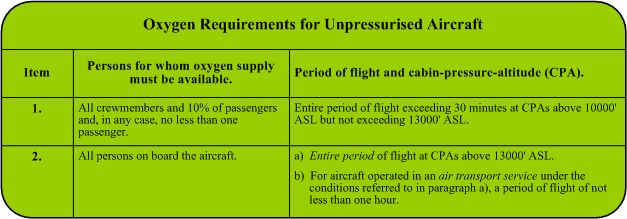
Pressurized Aircraft
No person may operate a pressurized aircraft unless it is equipped with, in the event of cabin pressurization failure at the most critical point during the flight, sufficient oxygen dispensing units and supply that are sufficient to continue flight to a suitable landing aerodrome while complying with the following:
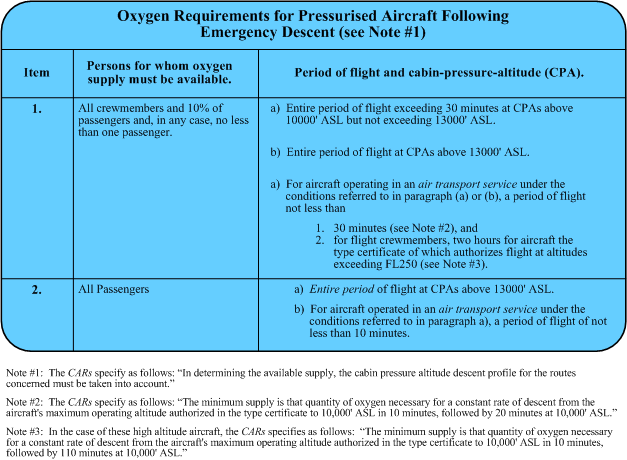
Documents on Board Aircraft
It is required that the following be carried on board aircraft: flight crew licences, including Medical Certificate and radio licence; Certificate of Registration and Certificate of Airworthiness; air crew radio licences; aircraft Journey Log (when it is planned that an aircraft will land and shut-down at an airport other than the airport of departure).
The Pilot Operating Handbook, interception orders, and aircraft weight and balance (including aircraft equipment list) must also be on board.
The Pilot Operating Handbook must be accessible to the pilot at his station.
Aircraft Equipment Requirements
CAR 605.14 Power-driven Aircraft - Day VFR
No person shall conduct a take-off in a power-driven aircraft for the purpose of day VFR flight unless it is equipped with
-
- where the aircraft is operated in uncontrolled airspace, an altimeter;
- where the aircraft is operated in controlled airspace, a sensitive altimeter adjustable for barometric pressure;
- an airspeed indicator;
- a magnetic compass or a magnetic direction indicator that operates independently of the aircraft electrical generating system;
- a tachometer for each engine and for each propeller or rotor that has limiting speeds established by the manufacturer;
- an oil pressure indicator for each engine employing an oil pressure system;
- a coolant temperature indicator for each liquid-cooled engine;
- an oil temperature indicator for each air-cooled engine having a separate oil system;
- a manifold pressure gauge for each
- reciprocating engine equipped with a variable-pitch propeller,
- reciprocating engine used to power a helicopter,
- supercharged engine, and
- turbocharged engine;
- a means for the flight crew, when seated at the flight controls to determine
- the fuel quantity in each main fuel tank, and
- if the aircraft employs retractable landing gear, the position of the landing gear;
- subject to Subsections 601.08(2)1 and 601.09(2),2 a radio-communication system adequate to permit two-way communication on the appropriate frequency when the aircraft is operated within
- Class B, Class C or Class D airspace,
- an MF area, unless the aircraft is operated pursuant to Subsection 602.97(3),3 or
- the ADIZ;
- where the aircraft is operated under Subpart 4 of this Part,4 or under Subpart 3, 4, 5 of Part VII,5 radio-communication equipment adequate to permit two-way communication on the appropriate frequency;
- where the aircraft is operated in Class B airspace, radio navigation equipment that will enable it to be operated in accordance with a flight plan; and
- where the aircraft is operated under Subpart 4 of this Part or under Subpart 5 of Part VII, radio navigation equipment that is adequate to receive radio signals from a transmitting facility.
CAR 605.15 Power-driven Aircraft - VFR OTT
- No person shall conduct a take-off in a power-driven aircraft for the purpose of VFR OTT flight unless it is equipped with
- the equipment referred to in paragraphs 605.14(c) to (j);
- a sensitive altimeter adjustable for barometric pressure;
- a means of preventing malfunction caused by icing for each airspeed indicating system;
- a gyroscopic direction indicator or a stabilized magnetic direction indicator;
- an attitude indicator;
- subject to Subsection (2), a turn and slip indicator or turn co-ordinator;
- where the aircraft is to be operated within the NDS, a means of establishing direction that is not dependent on a magnetic source;
- radiocommunication equipment adequate to permit two-way communication on the appropriate frequency; and
- radio navigation equipment adequate to permit the aircraft to be navigated safely.
- Where the aircraft is equipped with a standby attitude indicator that is usable through flight attitudes of 360 degrees of pitch and roll for an aeroplane, or ± 80 degrees of pitch and ± 120 degrees of roll for a helicopter, the aircraft may be equipped with a slip-skid indicator in lieu of a turn and slip indicator or turn co-ordinator.
CAR 605.16 Power-driven Aircraft - Night VFR
NOTE: Night begins when the centre of the sun is more than 6° below the horizon (generally, not less than 25 minutes after sunset or before sunrise).
- No person shall conduct a take-off in a power-driven aircraft for the purpose of night VFR flight, unless it is equipped with
-
- the equipment referred to in paragraphs 605.14(c) to (n);
- a sensitive altimeter adjustable for barometric pressure;
- subject to Subsection (2), a turn and slip indicator or turn co-ordinator;
- an adequate source of electrical energy for all of the electrical and radio equipment;
- in respect of every set of fuses of a particular rating that is installed on the aircraft and accessible to the pilot-in-command during flight, a number of spare fuses that is equal to at least 50 per cent of the total number of installed fuses of that rating;
- where the aircraft is operated so that an aerodrome is not visible from the aircraft, a stabilized magnetic direction indicator or a gyroscopic direction indicator;
- where the aircraft is to be operated within the NDA, a means of establishing direction that is not dependent on a magnetic source;
- where the aircraft is an airship operated within controlled airspace, radar reflectors attached in such a manner as to be capable of a 360-degree reflection;
- a means of illumination for all of the instruments used to operate the aircraft;
- when carrying passengers, a landing light; and
- position and anti-collision lights that conform to the Aircraft Equipment and Maintenance Standards.6
References
1 CARs 601.08 (2) states as follows: “The pilot-in-command of a VFR aircraft that is not equipped with radio-communication equipment capable of two-way communication with the appropriate air traffic control unit may, during daylight in VMC, enter Class C airspace if the pilot-in-command receives authorization to enter from the appropriate air traffic control unit before entering the airspace.”
2 CARs (601.09 (2) provides the same text as CARs 601.08 (2) (authorization for NORDO operations), except it is applicable to Class D airspace.
3 This CAR provides provision for NORDO (no radio) aircraft to operate in an MFA when the designated ground station is operating and there is prior co-ordination.
4 Subpart 4 governs “Private Passenger Operations” for turbine aircraft—corporate aircraft, etc.
5 Part VII denotes commercial operations—specifically, Air Taxi (Subpart 3), Commuter (Subpart 4), and Airline (Subpart 5) operations.
6 The specifications that govern position and equipment lights.
Night VFR Requirements for Commercial Operations
In addition to the general Night VFR equipment requirements outlined above, CAR 605.16 (4) requires that aircraft engaged in corporate or commercial Night VFR must additionally be equipped with the following:
- an attitude indicator;
- a vertical speed indicator;
- pitot heat;
- ambient air temperature gauges.
Legal Flight
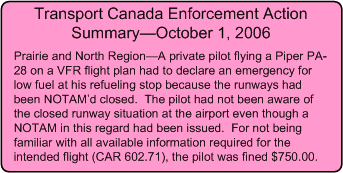
Before a flight, the Pilot-in-command must be familiar with available information appropriate for the intended flight (CAR 602.71) and must specifically be familiar with available weather information appropriate for the intended flight (CAR 602.72).
A pilot cannot legally fly an aircraft unless:
- the aircraft weight and load does not exceed the maximum permissible weight specified in the Pilot Operating Handbook;
- the load is properly disposed in the aircraft;
- the cargo and equipment is secured to prevent shifting and the passenger exits are not blocked;
- required emergency equipment is carried on board and is in good condition; and
- the aircraft is “safe and fit” for all aspects of the intended flight.
Operational and Emergency Equipment Requirements
Operational and emergency equipment requirements are set out in the CARs 602.60 through 602.63. Here are some highlights:
- All aircraft must have a checklist and/or placards to facilitate operation in accordance with the manufacturer’s requirements.
- The checklist and/or placards must provide for proper operation in normal, abnormal, and emergency flight conditions, and must specifically include the following:
- pre-start checks;
- pre-takeoff checks;
- post-takeoff checks;
- pre-landing checks; and
- emergency procedures checks.
- Emergency checks must specify emergency operation of hydraulic, electrical, and mechanical systems, emergency operation of instruments and controls, engine inoperative procedures, and any other procedures necessary for aviation safety. All checks and emergency procedures must be performed and followed by the flight crew.
- When operating VFR OTT, night VFR, or IFR, the aircraft must have all necessary charts and publications for the route flown, including any probable diversionary route; the charts and publications must be current.
- All aircraft must have accessible in the cockpit a suitable, non-toxic, and readily available fire extinguisher.
- Each crewmember (excluding passengers) must have access to a functioning timepiece and, when operating at night, a functioning flashlight
- All aircraft must have a first aid kit.
- Except when undertaking flight within 25 nautical miles of the airport of departure where continuous radio contact with base station is possible for the duration of flight, no person can operate an aircraft without specified survival equipment (CAR 602.61). The survival equipment must be adequate for the survival on the ground of each person on board the aircraft with due consideration for geographic area, seasonal and climatic variations; all survival equipment must provide a means for the following:
- starting a fire;
- providing shelter;
- providing or purifying water; and
- visually signalling distress.
Flight over Water
No person shall conduct a takeoff or landing on water in an aircraft, or operate an aircraft over water beyond a point where the aircraft could reach shore in the event of an engine failure, unless a lifejacket is carried on board for each person (CAR 602.62(1).
No person shall operate an aircraft more than 50 NM from shore unless a lifejacket is carried on board for each person (CAR 602.62(2).
The lifejackets must be stored on board in a fashion so as to be easily accessible to person for whom it is intended when that person is seated (CAR 602.62(4).
If a single-engine aircraft is operated over water beyond 100 nautical miles from a suitable emergency landing site, or if the aircraft is operated over water beyond a distance at which the same landing site cannot be reached within 30 minutes at the cruising speed specified in the flight plan or flight itinerary, the aircraft must be equipped with life raft sufficient in total rated capacity to accommodate all persons on board (CAR 602.63).
With respect to a multi-engine aircraft unable to maintain flight with any engine failed, the above 100 NM or 30 minute above rule applies. In the case of multi-engine capable of maintaining flight with any engine failed, the distance is extended to 200 NM and the time is extended to 60 minutes.
Aircraft Icing
It is illegal to conduct or attempt to conduct a takeoff in an aircraft that has frost, ice, or snow adhering to any of its critical surfaces (i.e., wings, control surfaces, rotors, propellers, horizontal stabilizers, vertical stabilizers, or any other stabilizing surface of the aircraft) (CAR 602.11).
Minimum Altitude
Over a built-up area (City, Town, Village, or assembly of persons), an aircraft must be flown at a sufficient altitude to allow a safe emergency landing, and at no time should that be below 1000’ above the highest obstacle within a 2000’ radius (except for the purposes of landing or taking-off) (CAR 602.14).
Over non-populous areas, an aircraft must be flown at an altitude that does not present a hazard to person or property, and at no time less than 500’ distance from any person, vessel, vehicle or structure (except for the purposes of landing or taking-off) (CAR 602.14).
Speed Limits
The maximum speed below 10000’ ASL is 250 KIAS.
Below 3000’ AGL and within 10 NM of a controlled airport, the maximum speed is 200 KIAS (the exception is greater airspeeds for safety reasons or ATC authorization).
Rules of the Air
Aircraft cannot fly less than 2000’ above an aerodrome, except for the purpose of landing or taking off (CAR 602.96(4)).
No person shall create a hazard to persons or property by dropping an object from the aircraft during flight (CAR 602.23).
No person shall operate an aircraft in proximity to another aircraft that may create a risk of collision (CAR 602.21).
An aircraft engine shall not be started unless a competent person occupies the pilot seat, or the aircraft is prevented from moving forward. No person shall leave an aircraft engine running unless a competent person is at the controls or, where no person is on board, precautions have been made to prevent the aircraft from moving forward and the aircraft is not unattended (CAR 602.10).
A pilot must land when instructed to do so by an ATCU, peace officer, customs or immigration officer, officer of the Armed Forces, or person authorized by the Minister.
A pilot must produce his licence and related documents upon demand by a peace officer, customs or immigration officer, officer of the Armed Forces, or person authorized by the Minister.
All crewmembers shall, during flight time, obey the orders, instructions, and commands of the Pilot-in-command (CAR 602.05).
When two aircraft are approaching head-on, each shall alter course to the right (CAR 602.19).
An aircraft overtaking another shall pass on the right.
When two aircraft are converging, the one on the right has the right of way, but must take whatever action necessary to avoid collision.
Based on manoeuvrability, aircraft have priority of right of way in the following order: fixed or free balloons, gliders, airships, and fixed or rotary wing aeroplanes.
A distressed aircraft has landing priority.
An aircraft towing another has priority over other aircraft.
If two aircraft are approaching for landing, the higher must give way to the lower.
An aircraft on the ground or in water must give way to an aircraft about to land.
Additonal Readings: The 10 Most-contravened Canadian Aviation Regulations.
.jpg)
